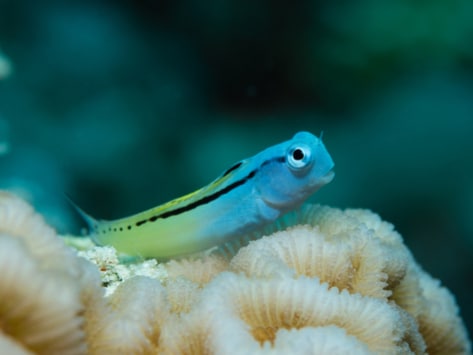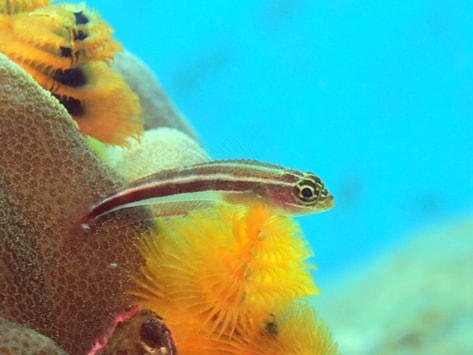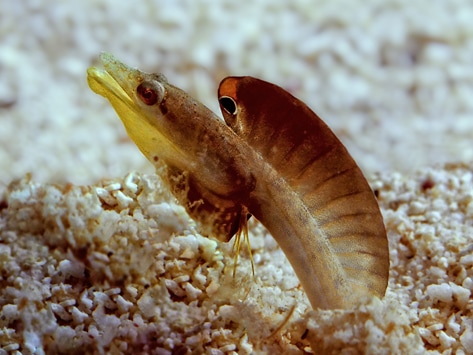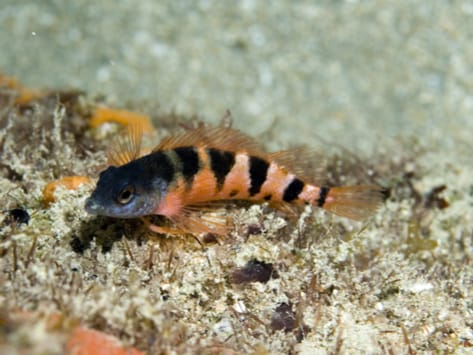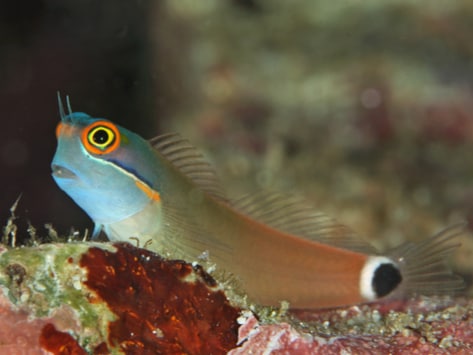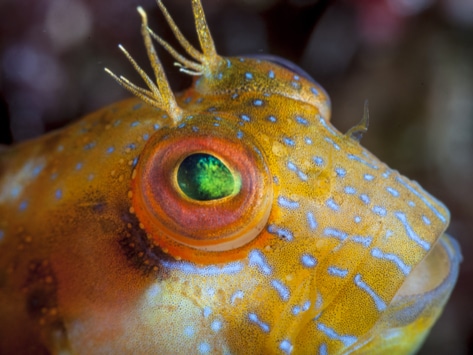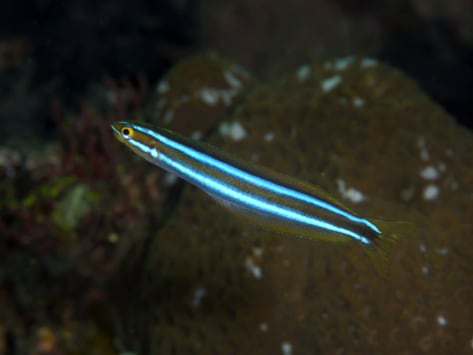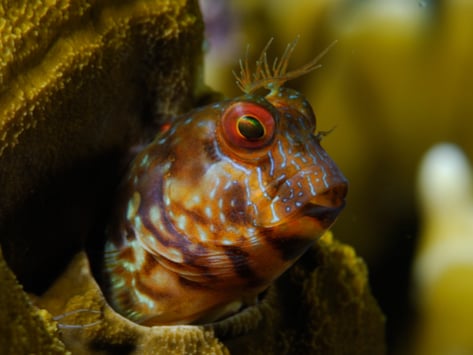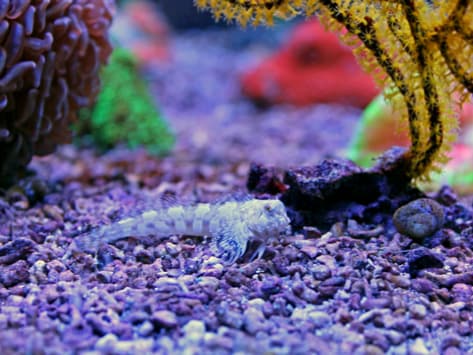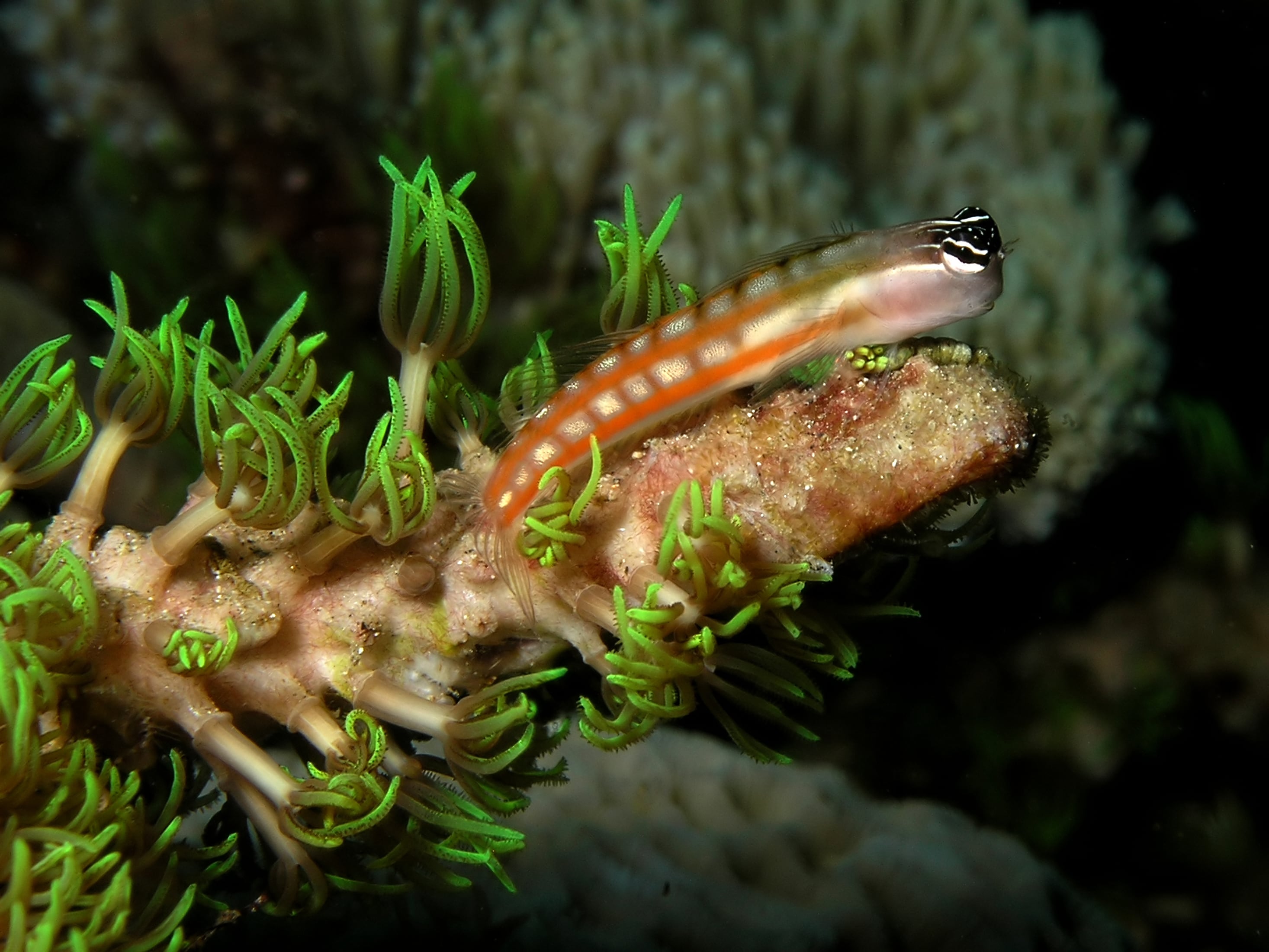Choosing and Caring for a Blenny Fish
By Kenneth Wingerter
With so many brilliantly hued marine fish available for the home aquarium, it’s easy to become smitten by their vibrant colors and exquisite finnage. Even so, most aquarists’ favorite specimens are often those that possess the most “personality.”
In terms of personality, few fish groups compare to the blennies. Combined with a (usually) good temperament and hyper-alertness, their daring antics make them quite entertaining to watch.
Compared to many other marine aquarium fish groups, blennies make for extremely low-maintenance pets. Simple to feed and comfortable in smaller tanks, these tough, disease-resistant fish seldom pose any major problems for even novice aquarists. To be sure, they provide much reward for the relatively simple care they require. More than a few hobbyists would describe their blenny’s appearance and behavior as “cute,” entertaining, and even comical.
With such endearing personality, along with being so temperamentally well suited for captivity, it is not surprising to so often see at least one blennioid inhabitant in most home marine aquaria.
As a group, the blennies are reliably reef-safe, and their small adult size and overall hardiness also make them an excellent choice for any marine aquarist, including beginner hobbyists or those with smaller-sized aquaria. Indeed, numerous blenny species have been staples in the ornamental fish trade for decades.
What is a Blenny?
As a group, the blennies are enormously varied. The so-called "true blennies" are known as blennioids and form their own taxonomical group. Though some aquarium literature speaks as though these true blennies form a family, the blennioids actually make up an entire suborder, with six families comprising the suborder Blennioidei. This suborder claims around 833 separate blenny species in 130 genera.
While they are rather species-rich, the blennioids share a few basic characteristics. They are mainly marine (that is, saltwater, though there are a few brackish and freshwater species), and they are strongly benthic in habit; that is, they are bottom dwellers (lake floor, sea bed, etc). They frequently exhibit strong nesting behaviors due to being demersal spawners — preparing nests at the bottom and laying their eggs there to develop.
The eyes and mouth of a blenny are relatively large. They oftentimes bear distinctive cirri — wispy antenna or whisker-like appendages — on their heads. Their bodies are long and sleek, some so long they resemble eels and snakes, but nearly all members of the blenny group are smallish in body size.
Image: Red Sea Mimic Blenny
Choosing a Blenny for the Home Aquarium
Representatives from most of the six blenny families are regularly available to marine aquarists. Though they certainly share some blenny-like traits, they vary somewhat from subgroup to subgroup in terms of how they should be cared for in captivity.
Triplefin Blenny
The triplefins (family Tripterygiidae), also called threefins, are a notable, even if not commonly kept, blennioid. The genera Tripterygion and Enneanectes claim around 100 species of oftentimes beautifully colored little fish. As their common name suggests, their dorsal fin is made up of three individual segments.
Only rarely available to hobbyists, attractive species such as the Niue Triplefin (Enneapterygius niue) can be extremely desirable.
Image: Triplefin Blenny
Sand Stargazer Blenny
The Sand Stargazers (family Dactyloscopidae) are interesting creatures. Sand Stargazers spend much of their time concealed beneath the sandy bottom of the seafloor, with only their eyes, nose, and mouth protruding above the surface of the sand.
The Stargazer’s physical adaptations for a mostly sedentary life of burrowing include bulging eyes on top of their head, an upturned mouth for catching prey, and a unique branchiostegal pump, which assists in breathing while buried.
Stargazers are more predatory than many of their fellow blennies. They are sit and wait predators, ready to snatch up any unsuspecting morsel that passes over them by opening their mouth like a trap door. They feed on small invertebrates (e.g., shrimp, snails) and tiny fish, so be aware of that before adding them to a multi-species tank.
While not especially widespread in the aquarium trade, the Red Saddled Sand Stargazer (Dactyloscopus pectoralis) has been available.
Image: Sand Stargazer / Wikimedia Commons
Clinid Blenny and Indonesian Weedfish
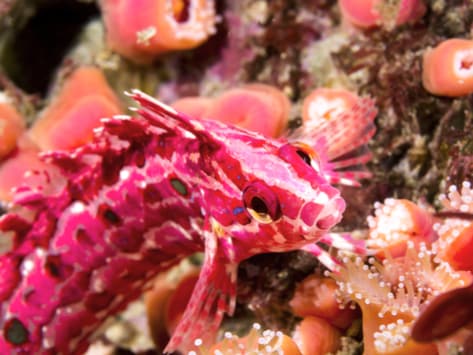
The clinid blennies (family Clinidae) can most quickly be identified by their long, continuous, soft-rayed dorsal fin and extremely elongate bodies.
While some species, such as the Indonesian Weedfish (Springeratus xanthosoma), have been collected for the tropical marine hobby, most clinids (e.g., the kelpfish) are collected for temperate aquaria.
Image: Crevice Kelpfish
Pikeblenny and Flagblenny
Though the Pikeblennies and Flagblennies (family Chaenopsidae) vary considerably in form, many have a skinny, scaleless body and a large, sail-like dorsal fin. The Orange Throat Pikeblenny (Chaenopsis alepidota) is a species that has recently become more available to aquarists.
Image: Yellow-Face Pikeblenny / Betty Wills via Wikimedia Commons
Labrisomid Blenny
The labrisomid blennies (family Labrisomidae) are not well represented in the aquarium trade at this time. One of the easier labrisomids to obtain is the Saddled Blenny (Malacoctenus triangulates).
These blennioids have pointier faces with bodies that superficially resemble the unrelated dragonet fish.
Image: Saddle Blenny
Combtooth Blenny
When people are talking about blennies in the aquarium, they are usually referring to one of the many species of Combtooth Blenny (family Blenniidae). The genera Blennius, Salarius, Ecsenius, and Meiacanthus include many popular aquarium species.
Image: Combtooth Blenny — ecsenius yaeyamensis
Where Do Blennies Come From, and Where Can They be Bought?
Fortunately, blennies readily breed in captivity. Several important aquarium species have consequently been cultured extensively and are now widely available to fish-keepers as captive-bred specimens. These cultured, captive-bred individuals are preferable to wild stock; they are hardier and better socialized, and they also present a decidedly more sustainable choice.
Quite a few well-liked fang blenny species (Meiacanthus spp.) are available as captive-bred, including M. bundoon, M. kamoharai, M. negrolineatus, M. oualanensis, and M. grammistes. The Red Sea Mimic Blenny (Ecsenius gravieri) has become a commonly used captive-bred species for nano aquaria.
The Molly Miller Blenny (Scartella cristata) is gaining popularity as the first captive-bred clean-up crew fish species (as opposed to cleaner shrimp and cleaner snail for the home aquarium).
More exotic blenny species, such as the Striped Blenny (Chasmodes bosquianus), the Feather Blenny (Hypsoblennius hentz), the Seaweed Blenny (Parablennius marmoreus [shown above]), the Mimic Fang Blenny (Petroscirtes breviceps), and the Peacock Blenny (Salaria pavo), have all been bred in captivity and could be widely cultured for the aquarium fish trade in the near future.
One blenny that you will want to consider carefully before adding to a mixed species tank is the Bluestriped Fangblenny (Plagiotremus rhinorhynchos [shown above]), which is a mimic of the Bluestreak Cleaner Wrasse, a symbiotic cleaner fish. While the Wrasse provides a cleaning service to larger fish by cleaning them of parasites, the Bluestriped Fangblenny imitates the “dance” and coloration of the Wrasse, but then takes a big bite out of the larger fish before quickly swimming away. Fortunately, the bite doesn’t hurt the bigger fish, owing to the numbing effect the blenny’s venom has on its victim, but you’ll still have an injured fish to tend to.
Captive Care for Blennies
Housing Blennies
Blennies are incredibly adaptable fish that thrive in a typical aquarium environment. They appreciate a rocky aquascape that has plenty of holes and crannies into which they may quickly dart at the slightest hint of danger. Blennies need places to hide, like rock caves, small spaces, and, for some, tube-like structures. They will even create their own burrows when they need to. So long as it has a few places to hide away, a tank as small as 20 gallons in volume will generally provide enough living space for a single blenny. They will be healthiest when water quality is optimal, they can also withstand less than pristine conditions.
It is a good idea to place a tight-fitting lid over any aquarium that houses a blenny, because while blennies are closely associated with being bottom dwellers, they can be spunky and flighty, as well. In some cases, they may even be prone to jumping out of the tank.
Image: Blenny at Home
Adding Blennies to a Mixed Species Tank
For the most part, blennies get along quite well with other fish. Because they are small in size, common sense should be exercised before mixing them with larger, more carnivorous species such as Lionfish, which may view the blenny as food – and conversely, with much smaller fish, which the blenny may view as food.
Some blennies will squabble over a particularly nice hiding spot, but they generally do not harass other fish. Even so, to avoid tense territorial disputes between members of their own species (especially between competing males), it is advisable to keep only one individual per species of blenny in a tank.
Image: Aegean Blenny
Feeding Blennies
Keepers rarely face any difficulty getting their blenny to feed. These greedy eaters are not picky and will usually accept any kind of fish food that can be offered.
As a rule of thumb, the types of blenny that spend more time swimming in the water column (e.g., fang blennies) will feed primarily on tiny crustaceans such as brine shrimp and mysis shrimp. Those that spend the majority of their time resting on the bottom (e.g., most of Blennius and Ecsenius) will be more omnivorous, feeding on small crustaceans as well as algal films or turfs.
Some, such as the aptly named Lawnmower Blenny (Salarius sp.), feed most heavily upon algae. As a matter of fact, certain herbivorous species, such as the Molly Miller Blenny, a cleaner fish, are used specifically to control nuisance algae growth in reef tanks.
Image: Australian Blenny / Wiki Commons
Read More
How to Plan a Single Species Aquarium
*Unless otherwise noted, all images were sourced from Shutterstock.

